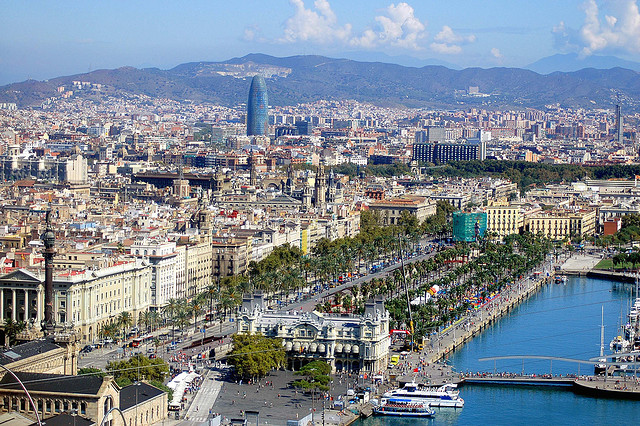June 19, 2015
 |
| Photo by Lutor44 via flickr |
Chris Leadbeater, The Daily Telegraph, June 20, 2015
Spain’s second city has a new mayor – who has controversial plans to cap the number of tourists in her popular home. Is this the (limited) future of travel?
They are not words you expect to hear from a politician. Especially not from a politician in so popular a destination. And especially not when they go against the general grain of the 21st century and attack one of the true boom industries of the modern world – tourism.
So the statements made by Ada Colau, the new mayor of Barcelona, in recent days, could well be considered seismic – a frank comment that you can have too many paying guests in one place, that too much interest in a city can be a bad thing. They may also come to be viewed as an inadvisable attempt to kill a golden goose. Time will tell on this.
Ms Colau arrived as the new municipal leader of Spain’s second city on Saturday, but has already begun setting out policies that many will consider daring . An anti-austerity figure, and head of the left-wing political group Barcelona en Comu, she has said that she wants to introduce a limit on the number of visitors who flock to the Catalan capital every year – perhaps via a freeze on hotel construction, or via tighter regulation of rental apartments.
“If we don’t want to end up like Venice, we will have to put some kind of limit in Barcelona,” she told newspaper El Pais in a recent interview.
“We can grow more, but I don’t know how much more.”
“We may have to put a moratorium in place regarding new hotels and tourist apartments, carry out a census and create a preventive policy before things get out of hand, as has occurred in Ciutat Vella [the city’s Old Town],” she added.
To some extent, she has a point. Anyone who has visited Barcelona during the summer months (or indeed, during the shoulder seasons) will have found their progress stunted by the sheer weight of people in their path – particularly if they are attempting to explore the notoriously busy main avenue of La Rambla, or the narrow alleyways of the Barri Gotic.
Nor is there any doubt that Barcelona has become one of Europe’s most popular cities for holidaymakers. Since it hosted the 1992 Summer Olympics – an event which, slickly presented, radically shifted the perception of the city from the idea of a crime-ridden relic to a bright enclave of beaches, bars and bravado architecture – Barcelona has been an enormous success story. While its infamously efficient pickpockets remain an issue, there is no indication that familiarity with the city will become contempt. In 2013, it welcomed 7.5 million tourists – six million from beyond Spain’s borders. In 2000, the relevant statistic was 3.14 million tourists – a doubling of numbers in the space of just 13 years.
Is 7.5 million extra bodies too many? Telegraph Travel’s Barcelona expert Sally Davies, a resident of the city, says that Ms Colau’s plans are largely well-intentioned, but that there is a danger of broad policy brushstrokes damaging the very city they are meant to protect.
“I am a fan of Ada Colau, and what she hopes to achieve,” she says. “But I hope she does not get swept up in the populist sentiment of ‘tourists go home’.”
“I hope she takes into account that a lot of businesses here, including century-old shops and tiny restaurants, have only managed to survive the recession thanks to the tourist dollar.
“What is really hurting the economy and the people, however, is the sub-letting of flats to tourists – which is pricing many locals out of the property market.
“I would hope she would focus on that in the first instance.”
Any cap on visitor levels would not be Barcelona’s first foray into reintroducing a little peace and quiet into its prime hotspots. Indeed, Ms Colau may be continuing a trend.
October 2013 saw the introduction of an €8 fee for entry into Parc Guell, Antoni Gaudi’s magical urban enclave of sculptures and exotic whimsy – which had previously been free.
And it emerged in April that larger tour parties were being barred from La Boqueria – the city’s iconic market hall on La Rambla – in order to give residents a chance to shop for fruit and vegetables without having to push past vast numbers of non-shoppers. Reports suggested that, in busy times, security guards were watching for groups of more than 15, and escorting them from the premises.
This move found favour with MyTelegraph blogger Anna Nicholas.
“Not only do these marauding groups restrict movement in the confined space,” she wrote, “but they prevent locals from going about their business – especially as those involved take endless photos and dawdle by stalls.”
Obvious questions remain about the feasibility of restricting tourist numbers under European Union laws on the freedom of movement – but if Barcelona’s new mayor succeeds in making her city’s streets a little less crowded, Rome, Venice and other hugely over-subscribed European city destinations may show an interest in copying her methods.
Five alternative cities for beating the crowds
If the idea of Barcelona or Rome at peak capacity fills you with dread and the urge to flee somewhere, anywhere else, here are five cities where the crowds are a little less colossal.
Valencia (Barcelona)
Considering that it is Spain’s third biggest city, Valencia still has a curious element of the undiscovered about it. This is remarkable. In its City of Arts and Sciences, it has a vast area of modernist architecture and culture which calls to every camera. There are long beaches on either side of the city, lapped by the same warm Mediterranean waters as Barcelona. And if you want noise, go in March for the bonfires of the Las Fallas festival.
• Valencia travel guide
Reader offers: find the perfect holiday in Spain
Naples (Rome)
It would be impossible to argue that Naples, with its tight streets and armies of scooters, is any less cluttered than Rome in high season. But this increasingly chic southern star has a special charm which plays out in the medieval maze of its Centro Storico and the leafy expanse of Capodimonte. Plus, if you want spectacular scenery and fascinating history, Mount Vesuvius and the ruins of Pompeii are both within feasible day-trip reach.
• Naples: Italy’s underrated gem
Reader offer: An eight-day private tour of Italy, exploring Naples, the Amalfi coast, Capri and Pompeii, costs from £1,499 per person. Includes b&b stays and return flight.
Lyon (Paris)
France’s second city has long claimed to be its culinary kingpin – and, as home to a host of Michelin-starred restaurants and top chefs, it has a point. But it can also match Paris for grand churches (the glorious hilltop Notre Dame de Fourviere) and parks (the epic Parc de la Tete D’Or), while eclipsing its rival on Roman heritage (the magnificent Fourviere amphitheatre) and key rivers (it has two, the Rhone and Saone, to Paris’s one).
• A cultural guide to Lyon
Reader offers: find the perfect holiday in France
Genoa (Venice)
No-one will ever claim that the Ligurian capital is as pretty as Venice, but this intriguing city on the Italian Riviera is far less busy than La Serenissima – and its Cattedrale di San Lorenzo, a splendid 12th century cathedral, adds a relevant element of religious majesty. If you forge out to the seafront districts of Boccadasse, Nervi and Portofino, you can also have all the café culture and waterfront views you want, minus Venice’s notorious prices.
Reader offers: find the perfect holiday in Italy
Budapest (Prague)
The Czech capital may well be Europe’s prettiest – but its centre is small, and it winding lanes can be more like clogged arteries in high summer. Contrast this with its Hungarian counterpart – a far bigger prospect in that, technically, it is two cities (Buda and Pest), separated by the timeless flow of the Danube. And if you want photogenic wonder, the Szechenyi (Chain) Bridge and St Stephen’s Basilica can rival any of Prague’s fine sites.
• 36 Hours In…Budapest
Reader offer: Three nights’ b&b at the five-star Boscolo Residence hotel in Budapest costs from £399 per person. Includes return flight and a walking tour of Castle HIll.
This article was written by Chris Leadbeater from The Daily Telegraph and was legally licensed through the NewsCred publisher network.
![]()
What do you think of this $type?










